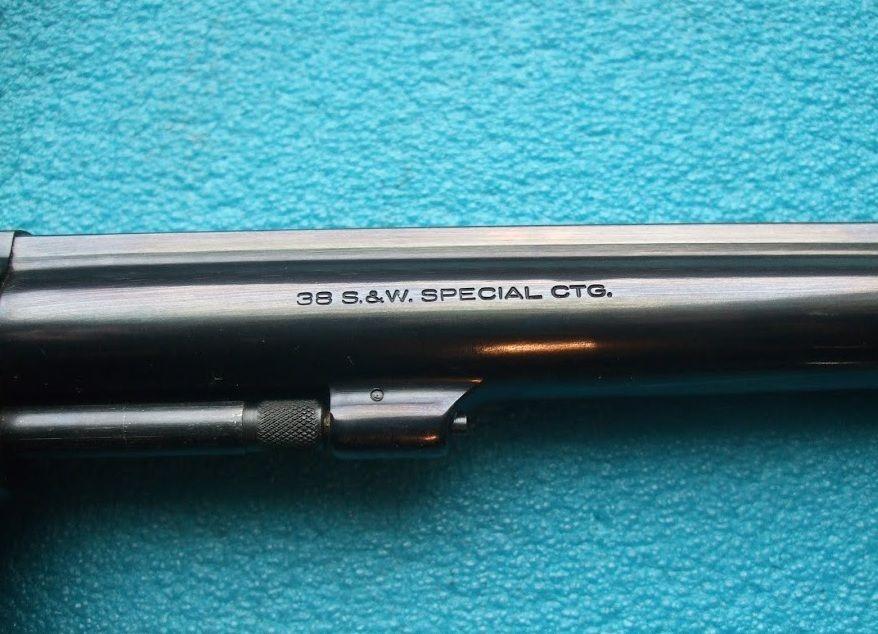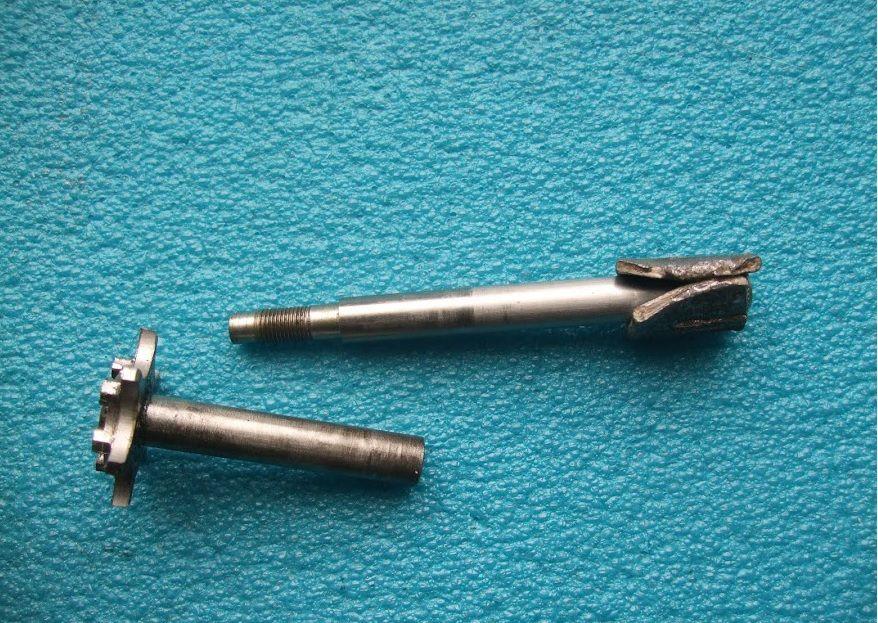Lee Martin
Hunter
S&W K-38 single action only .38 Special. A true .38 Special frame. This revolver has the wide Target Hammer and Target Trigger.

K-38 6-inch barrel rol marked for .38 Special. Standard S&W drop forged barrel, broach rifled 1:18-3/4" twist.

K-38 with industry-standard 11-degree forcing cone. Forcing cone cut square and short. Relatively thin barrel wall, due to small diameter stub. Forcing cone a little rough. Parts in photo which are drop forged include frame, barrel, extractor star, hammer, trigger, thumb piece, and sight base.

Model 66, stainless version of famed M-19 Combat Magnum. Hammer positioned to lift from frame. Squeeze trigger to position hammer for removal from frame. SINGLE ACTION DOG must clear HAND. DOUBLE ACTION SEAR, or "fly" (on hammer) must also clear HAND (which is mounted to trigger.)

M-66 frame, sideplate removed and partially stripped, reveals frame-mounted TRIGGER STOP. Trigger stop consists of an adjustable tab set in a slot at upper rear of TRIGGER GUARD. Adjustment secured by set screw. Should the screw loosen, tab can drop enough to prevent full trigger pull, disabling revolver. In practice, trigger stop should be removed altogether or secured with Loctite. This feature is not found on a Model 29 and other N-frames and doesn't belong on a fighting handgun. Once secured with Loctite, however, Bradshaw has never found the stop to loosen.

M-66 cylinder fouled enough to prevent normal trigger & hammer cocking; almost seized. Lead bullets and especially .38 Special accelerate carbon and grease fouling, which force between YOKE and CYLINDER. Solvent and 0000 steel wool do the trick, but cylinder must be stripped.

YOKE with combined bullet & powder fouling on cylinder axle. Yoke may be cleaned easily, as cylinder slides off. Axle should be lubed with Automatic Transmission Fluid or other light oil with anti-carbon properties

Cylinder must be disassembled to remove fouling. Parts include, clockwise from CYLINDER: EXTRACTOR rod, EJECTOR SPRING with GAS RING, YOKE, EJECTOR star, and CYLINDER PIN with spring. (Note lead wrapped around extractor rod.)

EJECTOR and EXTRACTOR rod. A piece of lead wraps knurled end of extractor rod to prevent marring with plier. Extractor rod screws into extractor its left hand thread——turn clockwise to loosen. Sequence performed with parts installed in cylinder. Before loosening or tightening extractor rod, chamber 3 to 6 fired cases. Fired cases act as a wrench to hold ejector, prevent damage to indexing pins and keyway.

Knurled end of extractor wrapped with lead to prevent damage from pliers. Remember, it has a left hand thread.

GAS RING on EJECTOR SPRING, with M-66 frame and cylinder.

Pachmayr Presentation small grips. Left: N-frame. Right: K-frame. These grips interchange in the hand. Exterior dimensions are the same, except for the top of the backstop. Much kinder to the base of the thumb than wood stocks when firing magnum loads.

Pachmayr Presentation grips, small size, for K-frame (left, and N-frame (right). Same grip in the hand. Excellent control and protection against powerful loads.

Shield to protect ejector rod made by flattening a lead bullet, in this instance a 158 SWC. Note on nomenclature: "extractor" and "ejector" are used interchangeably. Technically, "extractor" refers to that part which pulls a shell from the chamber, while "ejector" refers to the part which throws it free of the firearm. Terminology gets confused on double action revolvers and, by extension, single actions.

Despite shorter cylinder, the N-frame M-28, it is more resistant to gas & grease fouling than K-frame M-19 and M-66. Normal maintenance obviates any difference.

A pair of 4-inch magnums. From top: M-28 Highway Patrolman .357; M-29 .44.

Pair of old school 4-inch M-29s: low mileage and high mileage.

M-29 4-inch .44s, cocked to show Target Hammer with long & wide checkered spur (top), and bobbed spur (bottom). The bobbed hammer works better for gloved shooting in winter


K-38 6-inch barrel rol marked for .38 Special. Standard S&W drop forged barrel, broach rifled 1:18-3/4" twist.

K-38 with industry-standard 11-degree forcing cone. Forcing cone cut square and short. Relatively thin barrel wall, due to small diameter stub. Forcing cone a little rough. Parts in photo which are drop forged include frame, barrel, extractor star, hammer, trigger, thumb piece, and sight base.

Model 66, stainless version of famed M-19 Combat Magnum. Hammer positioned to lift from frame. Squeeze trigger to position hammer for removal from frame. SINGLE ACTION DOG must clear HAND. DOUBLE ACTION SEAR, or "fly" (on hammer) must also clear HAND (which is mounted to trigger.)

M-66 frame, sideplate removed and partially stripped, reveals frame-mounted TRIGGER STOP. Trigger stop consists of an adjustable tab set in a slot at upper rear of TRIGGER GUARD. Adjustment secured by set screw. Should the screw loosen, tab can drop enough to prevent full trigger pull, disabling revolver. In practice, trigger stop should be removed altogether or secured with Loctite. This feature is not found on a Model 29 and other N-frames and doesn't belong on a fighting handgun. Once secured with Loctite, however, Bradshaw has never found the stop to loosen.

M-66 cylinder fouled enough to prevent normal trigger & hammer cocking; almost seized. Lead bullets and especially .38 Special accelerate carbon and grease fouling, which force between YOKE and CYLINDER. Solvent and 0000 steel wool do the trick, but cylinder must be stripped.

YOKE with combined bullet & powder fouling on cylinder axle. Yoke may be cleaned easily, as cylinder slides off. Axle should be lubed with Automatic Transmission Fluid or other light oil with anti-carbon properties

Cylinder must be disassembled to remove fouling. Parts include, clockwise from CYLINDER: EXTRACTOR rod, EJECTOR SPRING with GAS RING, YOKE, EJECTOR star, and CYLINDER PIN with spring. (Note lead wrapped around extractor rod.)

EJECTOR and EXTRACTOR rod. A piece of lead wraps knurled end of extractor rod to prevent marring with plier. Extractor rod screws into extractor its left hand thread——turn clockwise to loosen. Sequence performed with parts installed in cylinder. Before loosening or tightening extractor rod, chamber 3 to 6 fired cases. Fired cases act as a wrench to hold ejector, prevent damage to indexing pins and keyway.

Knurled end of extractor wrapped with lead to prevent damage from pliers. Remember, it has a left hand thread.

GAS RING on EJECTOR SPRING, with M-66 frame and cylinder.

Pachmayr Presentation small grips. Left: N-frame. Right: K-frame. These grips interchange in the hand. Exterior dimensions are the same, except for the top of the backstop. Much kinder to the base of the thumb than wood stocks when firing magnum loads.

Pachmayr Presentation grips, small size, for K-frame (left, and N-frame (right). Same grip in the hand. Excellent control and protection against powerful loads.

Shield to protect ejector rod made by flattening a lead bullet, in this instance a 158 SWC. Note on nomenclature: "extractor" and "ejector" are used interchangeably. Technically, "extractor" refers to that part which pulls a shell from the chamber, while "ejector" refers to the part which throws it free of the firearm. Terminology gets confused on double action revolvers and, by extension, single actions.

Despite shorter cylinder, the N-frame M-28, it is more resistant to gas & grease fouling than K-frame M-19 and M-66. Normal maintenance obviates any difference.

A pair of 4-inch magnums. From top: M-28 Highway Patrolman .357; M-29 .44.

Pair of old school 4-inch M-29s: low mileage and high mileage.

M-29 4-inch .44s, cocked to show Target Hammer with long & wide checkered spur (top), and bobbed spur (bottom). The bobbed hammer works better for gloved shooting in winter

